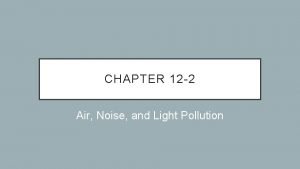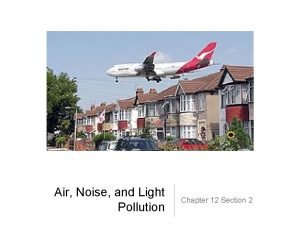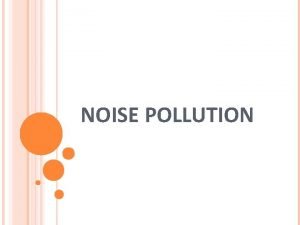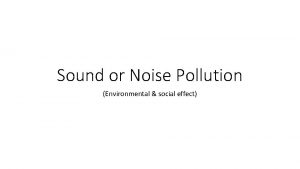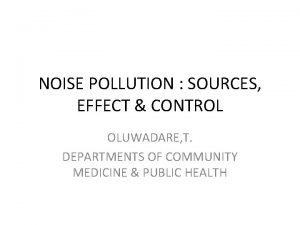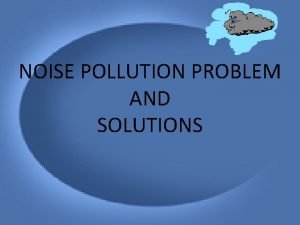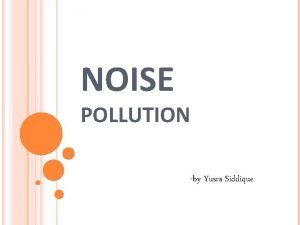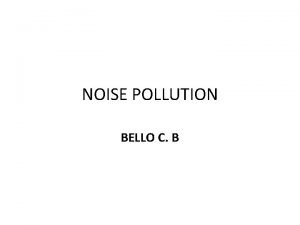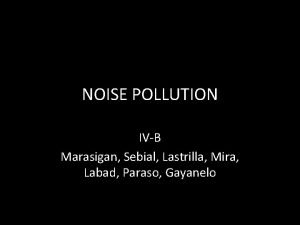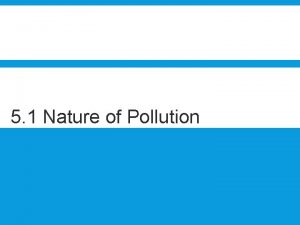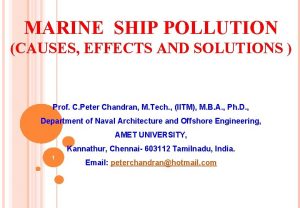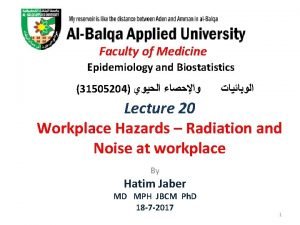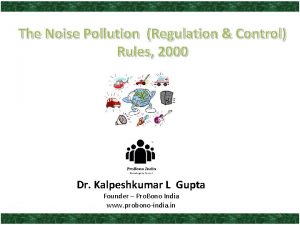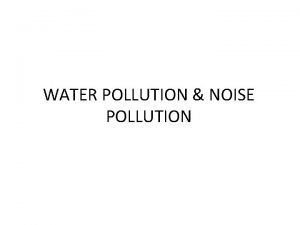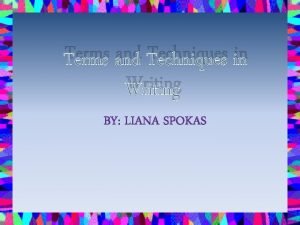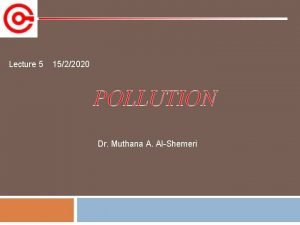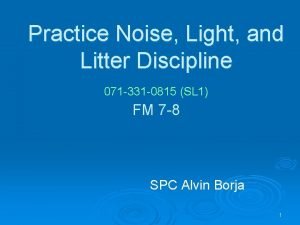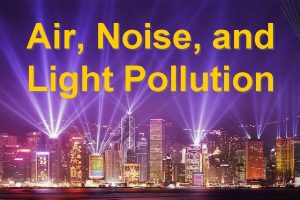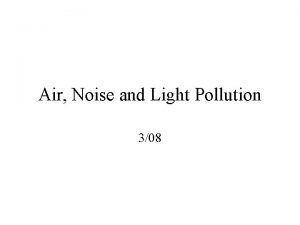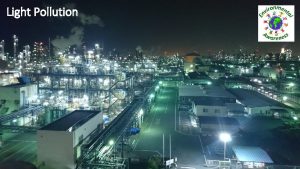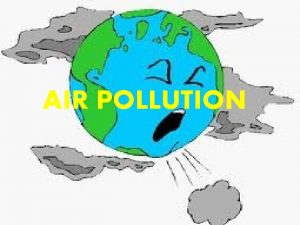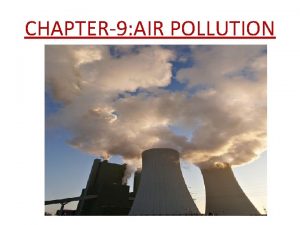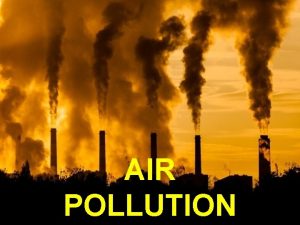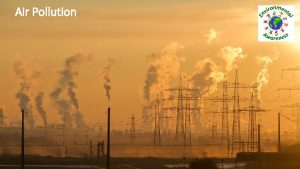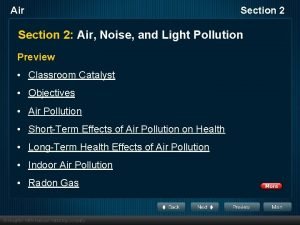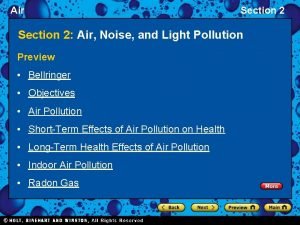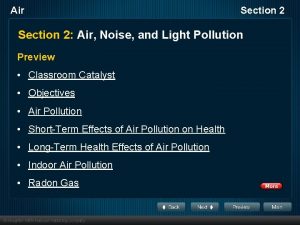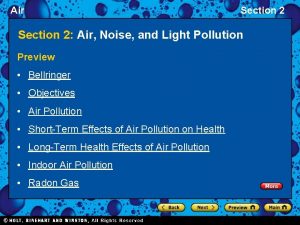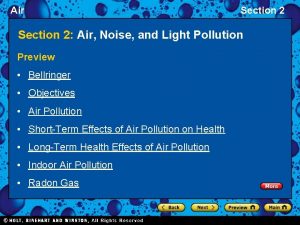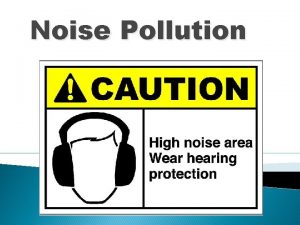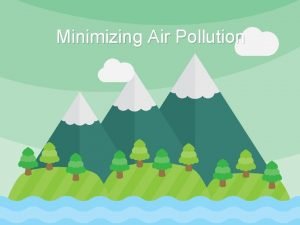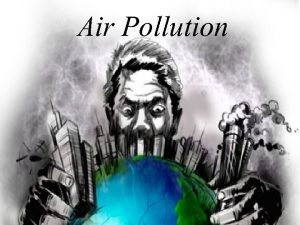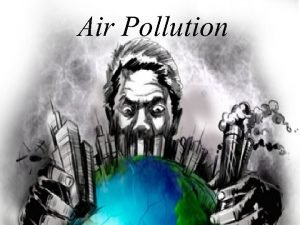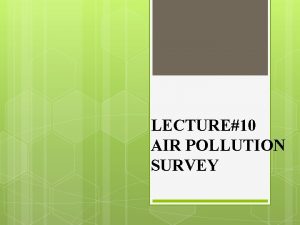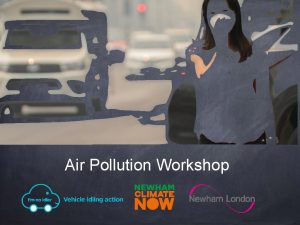CHAPTER 12 2 Air Noise and Light Pollution


























- Slides: 26

CHAPTER 12 -2 Air, Noise, and Light Pollution

WARM-UP

AIR POLLUTION • Air pollution cause serious health problems • very young, very old, or who have heart or lung problems. • Air pollution adds to the effects of existing diseases such as • Emphysema • Heart disease • Lung cancer • Americans pay tens of billions of dollars a year in health costs to treat respiratory diseases caused by air pollution.

SHORT-TERM EFFECTS OF AIR POLLUTION ON HEALTH • Many of the effects of air pollution on people’s health are short-term and reversible if their exposure to air pollution decreases. • The short-term effects of air pollution on people’s health include: • • • Headache Nausea Irritation to the eyes, nose and throat Coughing/tightness in the chest; Upper respiratory infections

LONG-TERM HEALTH EFFECTS OF AIR POLLUTION • Long-term effects on health that have been linked to air pollution include: • Emphysema • Lung cancer • Heart disease.

INDOOR AIR POLLUTION IS A SERIOUS PROBLEM • Developing countries • Indoor burning fuel wood, charcoal, manure • Poor suffer the greatest risk • Developed countries • Indoor air pollution is greater than outdoor air pollution

INDOOR AIR POLLUTION IS A SERIOUS PROBLEM

INDOOR AIR POLLUTION • Plastics and other industrial chemicals are major sources of pollution. • These compounds can be found in: • Carpets • Building materials • Paints • Furniture

INDOOR AIR POLLUTION

Chloroform Source: Chlorine-treated water in hot showers Possible threat: Cancer Para-dichlorobenzene Source: Air fresheners, mothball crystals Threat: Cancer 1, 1, 1 -Trichloroethane Tetrachloroethylene Source: Dry-cleaning fluid fumes on clothes Threat: Nerve disorders, damage to liver and kidneys, possible cancer Source: Aerosol sprays Threat: Dizziness, irregular breathing Nitrogen oxides Benzo- α -pyrene Source: Tobacco smoke, woodstoves Threat: Lung cancer Particulates Source: Pollen, pet dander, dust mites, cooking smoke particles Threat: Irritated lungs, asthma attacks, itchy eyes, runny nose, lung disease Source: Pipe insulation, vinyl ceiling and floor tiles Threat: Lung disease, lung cancer Source: Furniture stuffing, paneling, particleboard, foam insulation Threat: Irritation of eyes, throat, skin, and lungs; nausea; dizziness Styrene Source: Carpets, plastic products Threat: Kidney and liver damage Source: Unvented gas stoves and kerosene heaters, woodstoves Threat: Irritated lungs, children's colds, headaches Asbestos Formaldehyde Carbon monoxide Source: Faulty furnaces, unvented gas stoves and kerosene heaters, woodstoves Threat: Headaches, drowsiness, irregular heartbeat, death Tobacco smoke Source: Cigarettes Threat: Lung cancer, respiratory ailments, heart disease Methylene chloride Radon-222 Source: Radioactive soil and rock surrounding foundation, water supply Threat: Lung cancer Source: Paint strippers and thinners Threat: Nerve disorders, diabetes Fig. 18 -16, p. 484

INDOOR AIR POLLUTION • Sick-building syndrome: a set of symptoms, such as headache, fatigue, eye irritation, and dizziness, that may affect workers in modern, airtight office buildings. • Believed to be caused by indoor air pollutants. • Most common in buildings that are tightly insulated

INDOOR AIR POLLUTION • Ventilation, or mixing outdoor air with indoor air, is also necessary for good air quality.

ASBESTOS

ASBESTOS • Asbestos: any of six silicate minerals that form bundles of minute fibers that are heat resistant, flexible, and durable. • Asbestos is primarily uses as an insulator and a fire retardant • Extensively in building materials. • Banned in early 1970 s

ASBESTOS • https: //www. youtube. com/watch? v=Ku. HL 7 hi. FTnc

RADON GAS (RADON 222) • Radon gas is colorless, tasteless, odorless, and radioactive. • Radon is one of the elements produced by the decay of uranium 228 (a radioactive element) • Occurs naturally in the Earth’s crust. • Radon can seep through cracks and holes in building foundations

RADON GAS • Sources • Human health risks • Testing for radon • Correcting a radon problem

Outlet vents for furnaces and dryers Open window Cracks in wall Openings around pipes Slab joints Wood stove Cracks Clothes in floor Furnace dryer Slab Radon-222 gas Sump pump Uranium-238 Soil Fig. 18 -18, p. 485

NOISE POLLUTION • Some noises are unnecessary and can cause noise pollution. • Health problems include: • Loss of hearing • High blood pressure • Stress Can weaken immune system • Loss of sleep decreased productivity

NOISE POLLUTION • Decibel: is the most common unit used to measure loudness (d. B) • The quietest sound that a human ear can hear is represented by 0 d. B. • For each increase in decibel intensity, the decibel level is 10 x higher than the previous level. • A sound of 120 d. B is at the threshold of pain • Permanent deafness may come as a result of continuous exposure to sounds over 120 d. B.

NOISE POLLUTION

LIGHT POLLUTION • Light pollution does not present a direct hazard to human health, but it does negatively affect our environment. • Diminishes view of the night sky especially in urban areas

LIGHT POLLUTION • Energy waste: • Shield light so it is directed downward • Use time controls so that light is used only when needed

LIGHT POLLUTION

LIGHT POLLUTION • https: //www. youtube. com/watch? v=_nl. Fc. Ej 41 Xk

REVIEW QUESTIONS • Page 343 #20 -26 • Complete in your notes or on a separate sheet of paper (to be checked by me at the beginning o f next class)
 Section 2 air noise and light pollution
Section 2 air noise and light pollution Section 2 air noise and light pollution
Section 2 air noise and light pollution Section 1 what causes air pollution answer key
Section 1 what causes air pollution answer key Chapter 12 air section 1 what causes air pollution
Chapter 12 air section 1 what causes air pollution Light light light chapter 23
Light light light chapter 23 Into the light chapter 22
Into the light chapter 22 Light light light chapter 22
Light light light chapter 22 Noise pollution
Noise pollution Quantization noise in pcm
Quantization noise in pcm Conclusion for air pollution
Conclusion for air pollution Noise pollution introduction
Noise pollution introduction Sound pollution problems
Sound pollution problems Effects of noise pollution on human health pdf
Effects of noise pollution on human health pdf Noise pollution introduction
Noise pollution introduction 8 effects of water pollution
8 effects of water pollution Control of noise pollution ppt
Control of noise pollution ppt Noise pollution definition
Noise pollution definition Marine noise pollution
Marine noise pollution Solution of noise pollution
Solution of noise pollution Noise pollution act
Noise pollution act Example of noise pollution
Example of noise pollution Poem on noise pollution
Poem on noise pollution Noise pollution solution
Noise pollution solution Pt tanah air sentosa
Pt tanah air sentosa Noise light and litter discipline
Noise light and litter discipline Land water and air pollution
Land water and air pollution Land water and air pollution
Land water and air pollution
